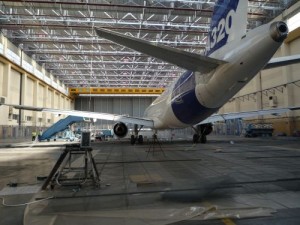 The National Aerospace Laboratory (NLR), in collaboration with Airbus, Eindhoven University of Technology and others, has conducted research to further chart the properties of lightning current.
The National Aerospace Laboratory (NLR), in collaboration with Airbus, Eindhoven University of Technology and others, has conducted research to further chart the properties of lightning current.
During the two-and-a-half-year EU-sponsored ILDAS (In-flight Lightning Damage Assessment System) project, a special measurement system was developed to record the lightning current on airborne aircraft. Twelve companies from five European countries collaborated to define the system and build a prototype. NLR, which served as the consortium’s coordinator, developed advanced measurement electronics that converts electrical signals into digital data.
Key features of this system are that it allows detection of a lightning strike, gives a measure of its intensity, and that it will determine which part of the aircraft was struck. Based on these research results, aircraft manufacturers can develop lightning strike test methods that closely reflect the real situation in the air. In addition, it becomes possible to limit flight delays caused by lightning strikes, because the ILDAS system relays information to the maintenance centre during the flight. Every aircraft struck by lightning is thoroughly checked after landing. Thus the sending of advance reports of lightning strikes during the flight allows the necessary personnel and equipment to be present on the ground when the aircraft lands.
Measuring lightning strikes is a difficult task: precise measurements must be conducted while the lightning is striking, without suffering signal disturbance. Lightning tests were conducted on an Airbus A320 in a hangar in Toulouse, France. During the tests, sensors, placed inside and outside the plane, registered the magnetic fields that were created by means of artificial lightning currents. These sensors collect data that is then sent via fibre-optic cables to a central computer, which stores all the measurement data, amounting to two gigabytes per entry. A computer program, specially developed for this purpose, then collects all this data, in order to reconstruct the lightning strike current and determine each entry’s most important properties, such as the peak current value.
During the tests in Toulouse, the ILDAS project’s participants successfully demonstrated that this measuring principle worked and the required properties could be determined. The aviation industry has expressed interest in using this measurement system for test aircraft.

